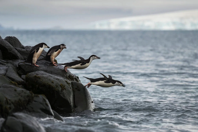
Chinstrap penguins are exquisitely adapted to their environment. They live and breed in some of the world’s harshest conditions, nesting in the windblown, rocky coves of the Antarctic Peninsula, a strip of land comprising the northernmost part of the frigid continent. In water they are precision hunters, darting after krill, the tiny shrimp-like crustaceans that are their sole food source, utilizing barbed tongues engineered for catching the slipperiest of prey. On land, these 2-2.5-foot-tall flightless birds are prodigious mountaineers, able to scale rocky escarpments in spite of their ungainly waddle. Their perfect adaptation to local conditions makes them the ideal barometer for the future of the region. If anything changes in the marine environment, the health of chinstrap penguins will be one of the most reliable indicators. They are the canaries of the Southern Ocean.
Image: Chinstrap penguins diving into the ocean at Snow Island, South Shetlands, Antarctica on Jan. 30, 2020. Christian Åslund —Greenpeace and TIME

